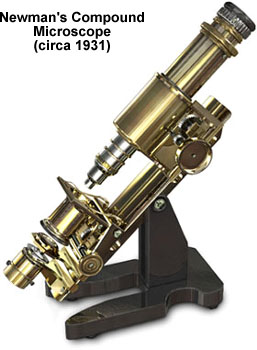Newman's Compound Microscope
In his book, Gerard Turner describes this microscope as a "home-made" British compound microscope made by Arthur S. Newman in 1931. The microscope was described by the inventor as being only a "sketch in metal", but it truly is a work of art.

The microscope, made from a hodgepodge of discarded parts, was exhibited on April 14, 1931 at a meeting of the Quekett Club, where the design won the approval of club members who later described the meeting in one of the Royal Microscopical Society journals. All of the primary components, including the body tube, stage, and condenser are mounted on a single limb that is supported on a pivot by a cast iron U-shaped foot. The optical components are designed to operate in "parallel" on this limb, bringing the conjugate planes onto a single axis. Course focus is achieved by rackwork operated with a knurled knob to raise and lower the body tube. Illumination is accomplished with a tungsten bulb placed in a housing below the condenser. The microscope is capable of using a variety of interchangeable objectives from different sources.
BACK TO TWENTIETH CENTURY MICROSCOPES
